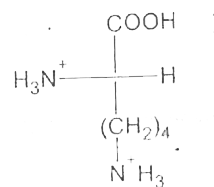Amino aicds behave like salts rather than simple aminess or carboxylic aicds. Explain.
In aqueous solution , the carboxyl group lose a proton and amino group accepts a proton to form a zwitter ion .
R−CH∣NH2−O∣∣C⇔R−CH∣NH3+(Zwitter ion)−O∣∣C−O−
Topper's Solved these Questions
- BOOK - U-LIKE SERIESCHAPTER - BIOMOLECULESEXERCISE - LONG ANSWER QUESTIONS - I22videos
BIOMOLECULES
- BOOK - U-LIKE SERIESCHAPTER - BIOMOLECULESEXERCISE - VERY SHORT ANSWER QUESTIONS67videos
BIOMOLECULES
- BOOK - U-LIKE SERIESCHAPTER - AMINESEXERCISE - SELF ASSESSMENT TEST6videos
AMINES
- BOOK - U-LIKE SERIESCHAPTER - CBSE EXAMINATION PAPER 2020 EXERCISE - SECTION D6videos
CBSE EXAMINATION PAPER 2020
Similar Questions
Knowledge Check
- Question 1 - Select One
Amino acids behave like salts rather than simple amines or carboxylic acids. This behavior is due to the presence of both acidic (COOH) and basic (−NH2 group in the same molecule. In aqueous solution, the carboxyl group can lose a proton and amino group can accept a proton, giving rise to a dipolar lon known as Zwitter ion.
Which of the following is the major species in a solution of lysine at pH = 3.5?A B
B C
C D
D
- Question 2 - Select One
Amino acids behave like salts rather than simple amines or carboxylic acids. This behavior is due to the presence of both acidic (COOH) and basic (−NH2 group in the same molecule. In aqueous solution, the carboxyl group can lose a proton and amino group can accept a proton, giving rise to a dipolar lon known as Zwitter ion.
Zwitter ion exists.A) at pH = 7Bin acidic mediumCin basic mediumDat a specific pH
Amino acids behave like salts rather than simple amines or carboxylic acids. Explain.
View SolutionExplain the following:
Amino acids behave like salts rather than simple amines or carboxylic acidsView SolutionAmino acids behave like salts rather than simple amines or carboxylic acids. This behavior is due to the presence of both acidic (COOH) and basic (−NH2) group in the same molecule. In aqueous solution, the carboxyl group can lose a proton and amino group can accept a proton, giving rise to a dipolar lon known as Zwitter ion.
Zwitter ion exists.View SolutionExplain the following :
(i) Amino acids behave like salts rather than simple amines or carboxylic acids.
(ii) The two strands of DNA are complementary to each other.View SolutionExplain the following :
(i) Amino acids behave like salts rather than simple amines or carboxylic acids.
(ii) The two strands of DNA are complementary to each other.
(iii) Reaction of glucose that indicates the carbonyl group is present as an aldehydic group in the open structure of glucose.View SolutionRead the given passage ans answer question number 1 to 5 that follow :
Amino acids are classified as acidic, baisc or neutral depending unpon the relative number of makes it neutral , more number of amino than carboxyl groups makes it basic and more carboxyl groups are compared to amino groups makes it acidic . The amino acids , which can be synthesised in the body and must be obtained through diet , are known as essential amino acids. Amino acids are usually colourless, crystalline solids . These are water -solute , high melting solids and behave like salts rather than simple amines or carboxylic acids . This behaviour is due to the presence of both acidic (carboxyl group) and basic (amino group) in the same mlecule . In aqueous solution , the carboxyl group can lose a proton and amino group can accept a proton , giving rise to a dipolar ion known as zwitter ion. This is neutral but contains both positive and negative charges. In zwitter ionic , form amino acids show amphoteric behaviour as they react both with acids and bases.
An amino acid contains two amino and one carboxylic group. In which class of amino acids would you place it ?View Solution

